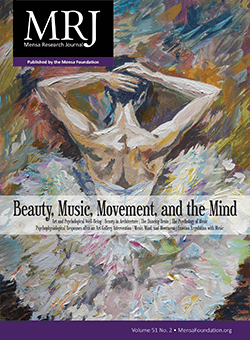
As I began seeking articles for this issue, I was looking for some research on how the arts affect your brain. Along the way, I learned about a relatively new area of research called neuroaesthetics.
An article in The Harvard Crimson provided me an informative introduction to the field, which is both innovative (merging art and science) and controversial (can science really tell us about aesthetic experiences?). A course in the Mind, Brain, and Behavior department there integrates “findings from neuroscience, psychology, evolutionary biology, philosophy, and scholarship in the arts and humanities.”
The articles presented in this issue aren’t restricted to neuroaesthetics, although you’ll find several related to that topic. As I browsed through journals and publications for this issue, I decided to include a variety of arts — painting, of course, but also music, dancing, and architecture — as well as different perspectives on how our aesthetic experience can affect what we think and feel in different contexts.
For example, a number of studies explore the benefits of art museum programs for dementia patients; the results of an exploratory study conducted in Australia are included in this issue. Another research area is the use of music as a therapeutic tool. Sifting through a bounty of material, I selected an article on emotion regulation with music as well as one researching a “Music, Mind and Movement” program.
The proliferation of public art indicates that people value having art in their everyday lives. Because it is both visually and physically accessible, and can be found in so many places — indoors and outdoors — one doesn’t even need to visit a museum to view the works. Many states have funded programs to ensure that art is included in new or renovated state buildings. Many communities, as well as companies and institutions, have some sort of a public art program. Sculpture gardens are some of my favorite places to walk and ponder … with fond memories of the one at the New Orleans Museum of Art.
The arts have brought me considerable satisfaction — whether it’s a symphony, a ballet, a museum, or quilting. For many, the social engagement and interaction involved in making or enjoying some form of art is also appealing. Many of us in the over-50 age group first heard classical music when we watched our favorite cartoons.
* * *
Published three times yearly, the Mensa Research Journal highlights scholarly articles and recent research related to intelligence from a diverse selection of nationally and internationally esteemed authors. Learn more about the MRJ and subscribe today.
Featured Research
- “Art and Psychological Well-Being: Linking the Brain to the Aesthetic Emotion,” by Stefano Mastandrea, Sabrina Fagioli, and Valeria Biasi (Frontiers in Psychology Vol. 10)
- “Beauty in Architecture: Not a Luxury — Only a Necessity,” by Semir Zeki (Architectural Design Vol. 89, No. 5)
- “Psychophysiological Responses in People Living with Dementia after an Art Gallery Intervention: An Exploratory Study,” by Nathan M. D’Cunha, Andrew J. McKune, Stephen Isbel, Jane Kellett, Ekavi N. Georgousopoulou, and Nenad Naumovski (Journal of Alzheimer’s Disease Vol. 72)
- “The Dancing Brain: Structural and Functional Signatures of Expert Dance Training,” by Agnieszka Z. Burzynska, Karolina Finc, Brittany K. Taylor, Anya M. Knecht, and Arthur F. Kramer (Frontiers in Human Neuroscience Vol. 11)
- “The Psychology of Music: Rhythm and Movement,” by Daniel J. Levitin, Jessica A. Grahn, and Justin London (Annual Review of Psychology Vol. 69)
- “A ‘Music, Mind, and Movement’ Program for People with Dementia: Initial Evidence of Improved Cognition,” by Olivia Brancatisano, Amee Baird, and William Forde Thompson (Frontiers in Psychology Vol. 10)
- “Emotion Regulation with Music in Depressed and Non-Depressed Individuals: Goals, Strategies, and Mechanisms,” by Laura S. Sakka and Patrik N. Juslin (Music & Science Vol. 1)









Comments (0)